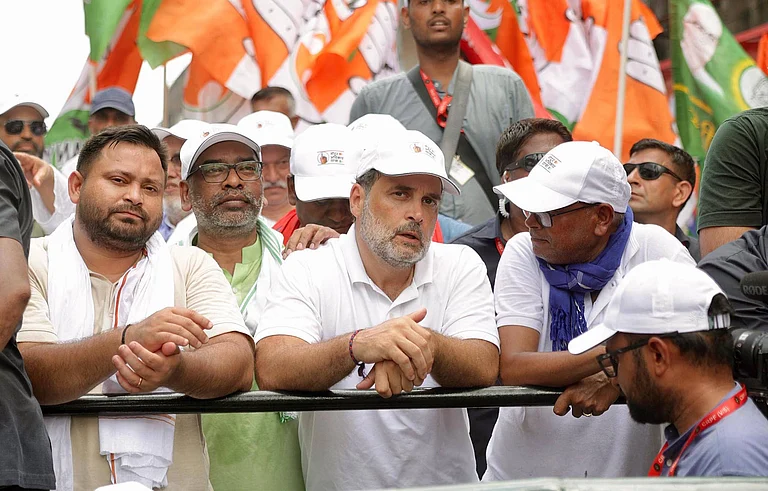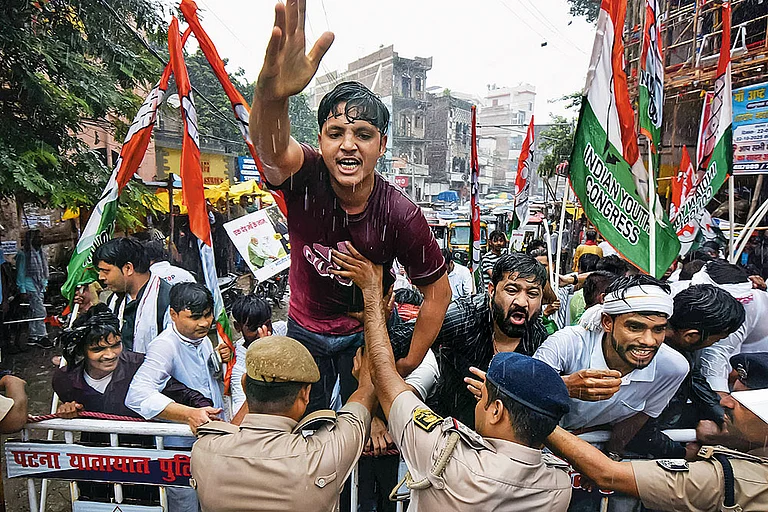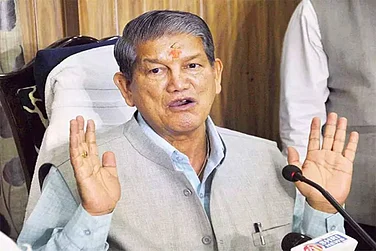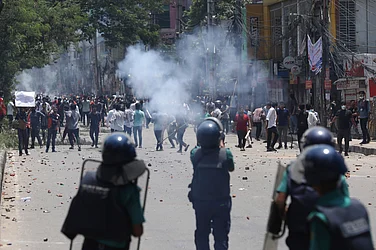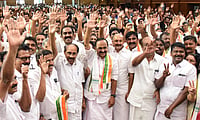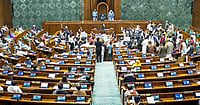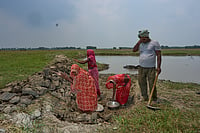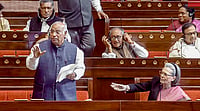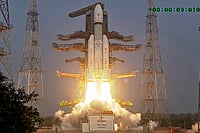
Bihar’s 2025 elections feature high-stakes contests in political family bastions — Nitish Kumar’s Harnaut, Tejashwi Yadav’s Raghopur, and Tej Pratap’s Mahua — where legacy, loyalty, and personal rivalries could redefine old loyalties.
The JD(U)-BJP seat swap in Tarapur, new entrants like Jan Suraaj, and RJD’s attempts to reclaim Sheohar and Raghunathpur signal evolving ground equations, with each seat holding symbolic and strategic significance.
Seat-sharing friction has led to Congress, RJD, and CPI(ML) clashing in multiple constituencies, testing the INDIA bloc’s unity even before polling — a factor that may influence the eventual balance of power in Bihar.
In less than three weeks, Bihar would have voted and the decisions on winners and kingmakers would have come to light. It’s not just about the winners, but also about fights in constitunies which could shape the results and the aftermath.
A few of these constituencies are family bastions, clashes within families, prestige battles, and home turfs Nitish Kumar’s turf Harnaut holds symbolic value, while Raghopur remains the Yadav family stronghold. Tejashwi Yadav defends Raghopur, while his estranged brother Tej Pratap returns to contest Mahua. RJD ishioping to win back its turfs Sheohar and Raghunathpur.
Harnaut: Nitish Kumar’s Legacy
This is the Constituency from where Nitish Kumar first entered the Assembly in 1985. Though the constituency remains a JD(U) stronghold, Nitish himself has mostly served as a member of the Bihar Legislative Council since taking office as Chief Minister in 2005. His village, Kalyan Bigha, lies just three kilometres from Harnaut.
Nitish last contested an Assembly election in 1995, again from Harnaut, securing victory as he had a decade earlier in 1985 on a Lok Dal ticket. He contested Lok Sabha elections in 2004 from both Barh and Nalanda, but he lost the former and won the latter seat.
In recent years, JD(U)’s Harinarayan Singh has been winning comfortably winning the seat by margins of 15,042 votes in 2010, 14,295 in 2015, and 27,241 in 2020. In the last Assembly election, the LJP finished second, while Congress as part of the RJD-led Mahagathbandhan banner trailed far behind with 13.3 per cent of the vote. This time, Congress is pinning its hopes on Arun Kumar Bind to challenge JD(U)’s dominance.
Raghopur: The RJD Family bastion
Raghopur, long considered the Yadav family’s stronghold and a bastion of the RJD, remains one of Bihar’s most closely watched constituencies this election. Lalu Prasad Yadav won the seat in 1995 and 2000, serving as Chief Minister both times. His wife, Rabri Devi, represented Raghopur three times, including the 2000 by-election and two subsequent assembly terms. Their son, Tejashwi Yadav, has held the seat since 2015.
This time, Tejashwi faces BJP’s Satish Kumar Yadav and Jan Suraaj Party’s Chanchal Singh. The contest carries historical weight: Satish defeated Rabri Devi in 2010 by 13,006 votes, securing 64,222 to her 51,216, before losing to Tejashwi in 2015 and 2020.
Tejashwi will look to preserve his family’s decades-long grip on Raghopur, while the BJP seeks to reclaim its brief 2010 victory. With Jan Suraaj entering the fray, a split in votes could make Raghopur yet again a fiercely contested seat in Bihar politics.
Mahua: RJD’s prodigal son’s seat
Tejashwi’s elder brother, Tej Pratap Yadav, 37, is contesting from the Mahua seat in Bihar’s Vaishali district as a Janshakti Janata Dal (JJD) candidate. Mahua has gained attention after Tej Pratap, expelled from the RJD, announced his political comeback through his new party.
The constituency has a strong Yadav vote base, along with 21.17 per cent Scheduled Caste and 15.10 per cent Muslim voters, making it a key seat in Bihar politics. Tej Pratap first won from Mahua in 2015 with 66,927 votes but shifted to Hasanpur in 2020. The seat is currently held by Mukesh Kumar Raushan of the RJD, who won the 2020 election with 62,747 votes and will again face Tej Pratap this time.
Adding to the triangular contest, the Lok Janshakti Party (Ram Vilas), part of the NDA and led by Chirag Paswan, has fielded Sanjay Singh. With three prominent contenders, Mahua is set for a high-profile and closely fought battle.
Hasanpur: An open field
The Hasanpur seat in Bihar, once represented by former RJD leader Tej Pratap Yadav, has been a key contest for both the JD(U) and the RJD. Located in the Rosera subdivision of Samastipur district, it was earlier held by JD(U) leader Raj Kumar Ray for two consecutive terms. This time, the RJD has fielded Mala Pushpam, while Ray will once again contest on a JD(U) ticket.
In the 2020 election, Tej Pratap Yadav won Hasanpur with 80,991 votes, defeating Raj Kumar Ray, who secured 59,852. In 2015, however, Ray had won with 63,094 votes. With Yadav not contesting this time, it remains to be seen whether Hasanpur voters will return their support to Ray in the 2025 Bihar elections.
Tarapur: A shake-up and a power shift
Tarapur, in Bihar’s Munger district, is among the key constituencies to watch in the 2025 Assembly elections. Traditionally a JD(U) stronghold, it has now been allocated to the BJP under the seat-sharing arrangement, signalling a major shift in alliance strategy. The move has drawn attention as Bihar Deputy Chief Minister and BJP leader Samrat Choudhary enters the race, calling Tarapur his ancestral seat and adding personal significance to the contest.
With sizable Kushwaha, Yadav, Muslim, and Scheduled Caste populations, Tarapur has long witnessed close battles between the JD(U) and RJD. Since 2010, however, the JD(U) has maintained its dominance. The BJP’s entry now makes the 2025 election a key test of the NDA’s strength against the Mahagathbandhan. Voting will take place in the first phase on November 6, and the result could shape the broader political narrative in Bihar.
In 2020, JD(U)’s Mewa Lal Choudhary won Tarapur with 63,463 votes, securing 38.76 per cent of the total. He had also triumphed in 2015 with 66,049 votes, or 43.78 per cent.
Lakhisarai: Easy Win for BJP
Lakhisarai is one of the most closely watched constituencies in the 2025 Bihar assembly elections. It is the home turf of Vijay Kumar Sinha, Deputy CM and former Speaker of the Bihar Assembly, who is contesting for a fifth term. Voting will take place in the first phase on November 6, 2025.
Part of the politically active Munger region, Lakhisarai’s outcome will hinge on caste equations based on Yadav, Bhumihar, and OBC voters. For the BJP, this is a prestige battle, as Sinha’s performance will reflect the party’s rural strength.
In the 2020 elections, Sinha won with 74,212 votes, repeating his 2015 victory when he secured 75,901 votes and a 40.8 per cent vote share. The BJP has dominated Lakhisarai for over a decade, winning three consecutive terms since 2010.
Formed in 1977, the constituency has seen representation from the Janata Party, Congress, JD(U), and RJD, but since 2010 it has remained a BJP stronghold, backed largely by Bhumihar and upper-caste voters along with OBC support within the NDA. The Mahagathbandhan has struggled to dent this hold, making Lakhisarai one of the NDA’s safest seats in the Munger region.
Alinagar: Will BJP Claim it?
Alinagar has drawn attention after folk singer and BJP leader Maithili Thakur announced her candidacy, set to face RJD’s Vinod Mishra in the upcoming Bihar elections. Once an RJD stronghold, the seat saw an upset in 2020 when Vikassheel Insaan Party’s Mishri Lal Yadav defeated Mishra, ending RJD’s long dominance; Yadav later joined the BJP in 2022.
In 2015, RJD’s Abdul Bari Siddiqui had beaten BJP’s Yadav by over 13,000 votes. With Thakur in the fray, the BJP aims to claim the constituency, making Alinagar one of the most closely watched contests this year.
Sheohar: Legacy comes to play
Sheohar, a politically sensitive constituency, was last won by Chetan Anand, son of former MP Anand Mohan, who contested on an RJD ticket but later joined the JD(U). The RJD had secured the seat, but its MLA switched sides last year. Historically, the RJD has dominated here with five wins, followed by Congress (four), and JD(U) and Janata Dal (two each).
This year, Anand is contesting from Nabinagar. Sheohar goes to polls in the second phase on November 11.
The RJD has fielded Navneet Jha, grandson of former Union minister Raghunath Jha. Neeraj Singh represents Jan Suraaj, while JD(U)’s Shweta Gupta is the NDA candidate. The district itself was carved out of Sitamarhi in 1994 through the efforts of Raghunath Jha.
Raghunathpur: RJD’s bid to claim it back
RJD has fielded Osama Shahab, son of late party strongman and former MP Mohammad Shahabuddin, from Raghunathpur in Siwan — currently held by RJD’s Hari Shankar Yadav. Lalu Prasad personally handed Osama the party symbol, marking his political debut. In a notable shift, RJD ally CPI(ML), once a fierce opponent of Shahabuddin, has said it now has “no dispute” with his family.
Shahabuddin, a close Lalu aide, fell out of party favour after his death in 2021. His widow, Hena Shahab, has contested multiple times from Siwan, most recently as an Independent in 2024, where her 2.93 lakh votes hurt the RJD’s chances. Osama’s entry signals RJD’s bid to reclaim Siwan’s political legacy. He faces JD(U)’s Vikas Kumar Singh (Jishu Singh) in a closely watched contest.
Pipra: A bellwether constituency
This time, Anil Kumar (CPI-MLA), Ram Vilas Kamat (JDU), and Indradev Sah (JSP) are the main contenders. In 2020, JDU’s Rambilash Kamat defeated RJD’s Vishwa Mohan Kumar by 19,245 votes. The RJD had won the seat in 2015, while the JDU, then allied with the BJP, claimed it in 2010 and formed the government. The constituency was created during the 2008 delimitation.
'Friendly fights' within the INDIA Bloc
Despite being allies, the Congress and RJD will face each other in several constituencies. On Monday, the RJD released its list of 143 candidates, ending prolonged seat-sharing talks within the alliance. The final division stands at RJD 143, Congress 61, CPI(ML) 20, and 15 seats for Mukesh Sahani’s Vikassheel Insaan Party (VIP).
Several “friendly contests” are expected across the state:
Congress vs RJD: Vaishali, Warisaliganj, Lalganj, Kahalgaon
Congress vs CPI: Bachhwara, Rajapakar, Rosera, Biharsharif
As Bihar heads to the polls in November, these high-stakes constituencies will not only decide individual winners but also shape the balance of power in the state, while testing strongholds and alliances.








